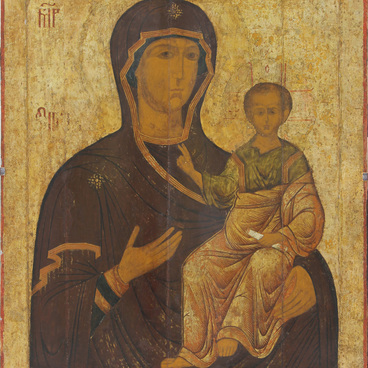The iconographic type of the ‘Burning Bush’ was formed in Byzantine art in the 12th century. In Russia, such icons appeared later, in the middle of the 16th century. Their theme is based on Prophet Moses’ vision of the burning bush from which the Lord spoke to him. The icon was called the Burning Bush.
The Mother of God of the Burning Bush
Время создания
End of the 18th or beginning of the 19th century
Размер
77,5x61,9 cm
77.5x61.9x3.2 cm
77.5x61.9x3.2 cm
Техника
Wood, tempera
2
Открыть в приложении#1

Unknown author
The Mother of God of the Burning Bush
#7
#3
Composition
#2
The composition consisted of two four-pointed stars superimposed on each other. In the center of the upper figure, the Mother of God was depicted with Jesus on her left arm, while scenes with angels from the Old Testament were painted in the rays and around the star. Angels serve God the Father, Lord Sabaoth. They control the elements, so they are depicted with a goblet of fire, snow, or with a beam of lightning. In the corners of the icon, painters depicted the visions of prophets. A burning bush appeared to Moses, Isaiah saw a Seraph with burning coals in tongs, Jacob saw a stairway to heaven, and Ezekiel beheld the closed heavenly gates.The composition consisted of two four-pointed stars superimposed on each other. In the center of the upper figure, the Mother of God was depicted with Jesus on her left arm, while scenes with angels from the Old Testament were painted in the rays and around the star. Angels serve God the Father, Lord Sabaoth. They control the elements, so they are depicted with a goblet of fire, snow, or with a beam of lightning. In the corners of the icon, painters depicted the visions of prophets. A burning bush appeared to Moses, Isaiah saw a Seraph with burning coals in tongs, Jacob saw a stairway to heaven, and Ezekiel beheld the closed heavenly gates.
#5
History
#6
Old icons often bear explanatory inscriptions that help the historians establish their date of creation. For example, in the 11th century these inscriptions were written without spaces, and the height of the letters was equal to their width. On the icon from the State Art Museum of Khanty-Mansiysk, the lines are divided into words, and the letters have elongated shape with drop-shaped elements. Such a script appeared in the 17th century, and also decorated the icons of 18th and 19th centuries.
So called arks, or recessed median areas, also help determine the time when an icon was created. They were carved to make a frame around the edges of the icon, and to protect the main image from scratches. The ark simplified the last-stage finishing of the icons: boiled linseed oil was poured into it, like into a bath. From the 17th and 18th centuries, icons were painted on even bases without any recesses, and the frame was painted.
#8
The icon ‘Mother of God of the Burning Bush’ was painted in Yaroslavl, in late 18th or early 19th century. The iconography in this region was distinguished by bright colors, ornamental designs and emotional characters.
After the revolution, the Burning Bush was kept in the collection of collector Viktor Samsonov in Saint-Petersburg. In 1996, it was acquired by the Khanty-Mansiysk Generation Fund for the Gallery ‘Rarities and treasures of art.’ Fifteen years later, the icon was transferred to the collection of the State Art Museum.
After the revolution, the Burning Bush was kept in the collection of collector Viktor Samsonov in Saint-Petersburg. In 1996, it was acquired by the Khanty-Mansiysk Generation Fund for the Gallery ‘Rarities and treasures of art.’ Fifteen years later, the icon was transferred to the collection of the State Art Museum.
#9
State Museum of Fine Arts of Khanty-Mansiysk
читать дальшескрыть
00:00
00:00
1x
The Mother of God of the Burning Bush
Время создания
End of the 18th or beginning of the 19th century
Размер
77,5x61,9 cm
77.5x61.9x3.2 cm
77.5x61.9x3.2 cm
Техника
Wood, tempera
2
Открыть в приложении
Поделиться

